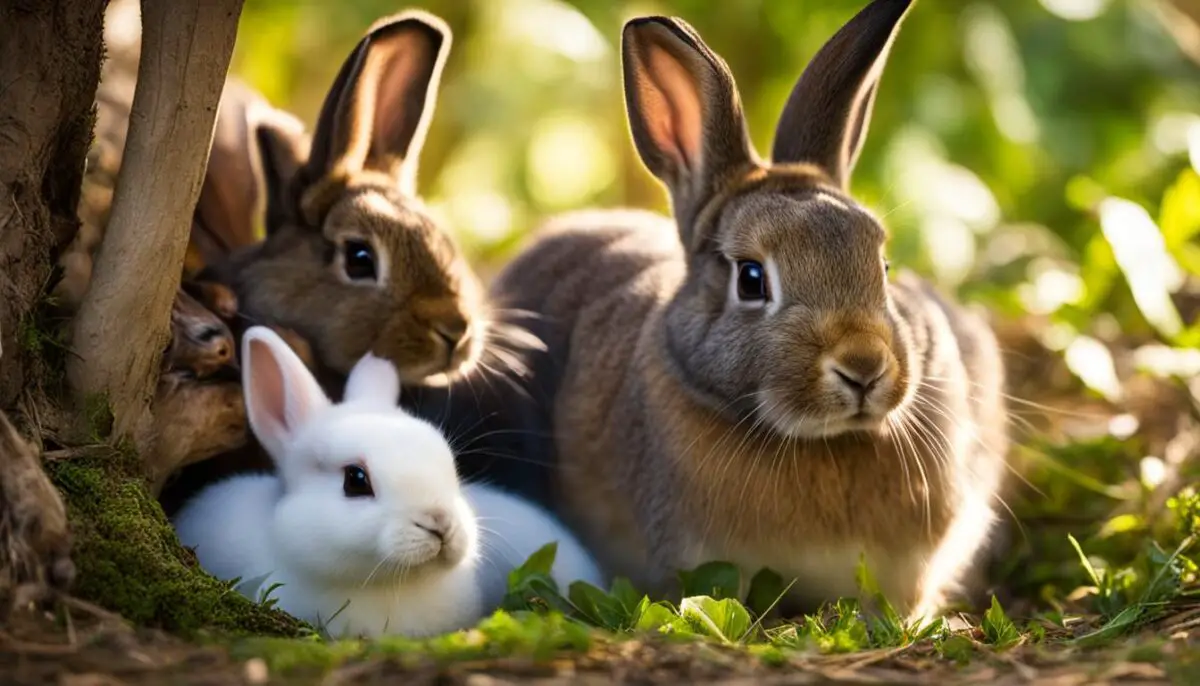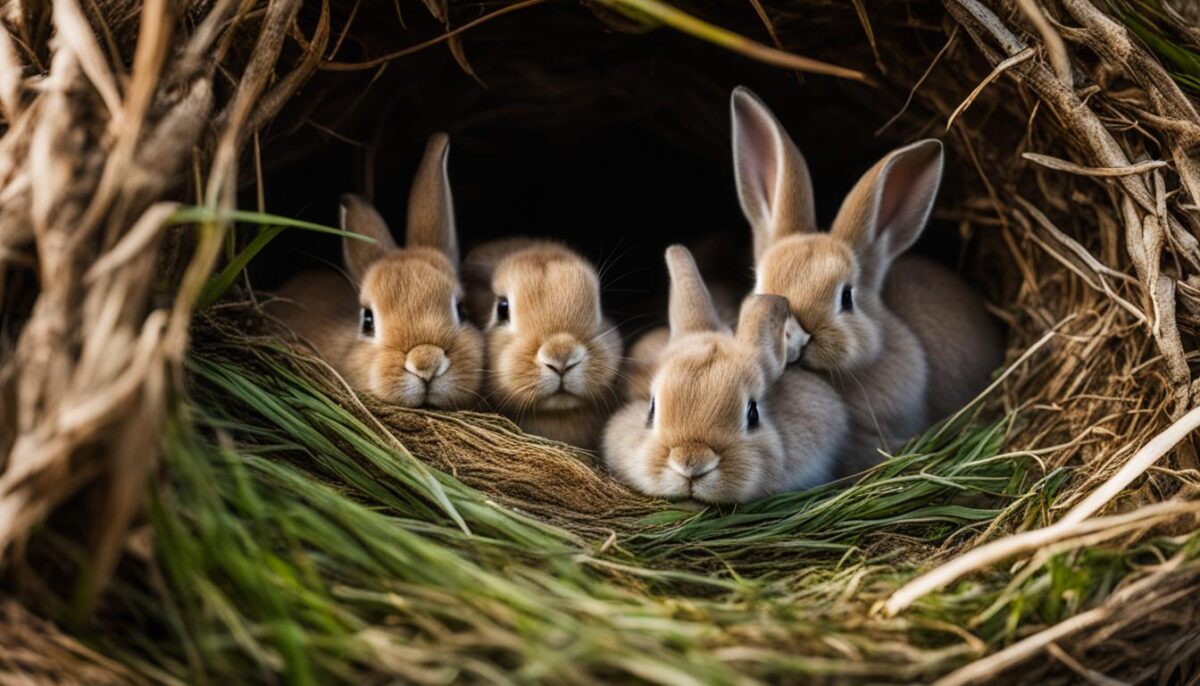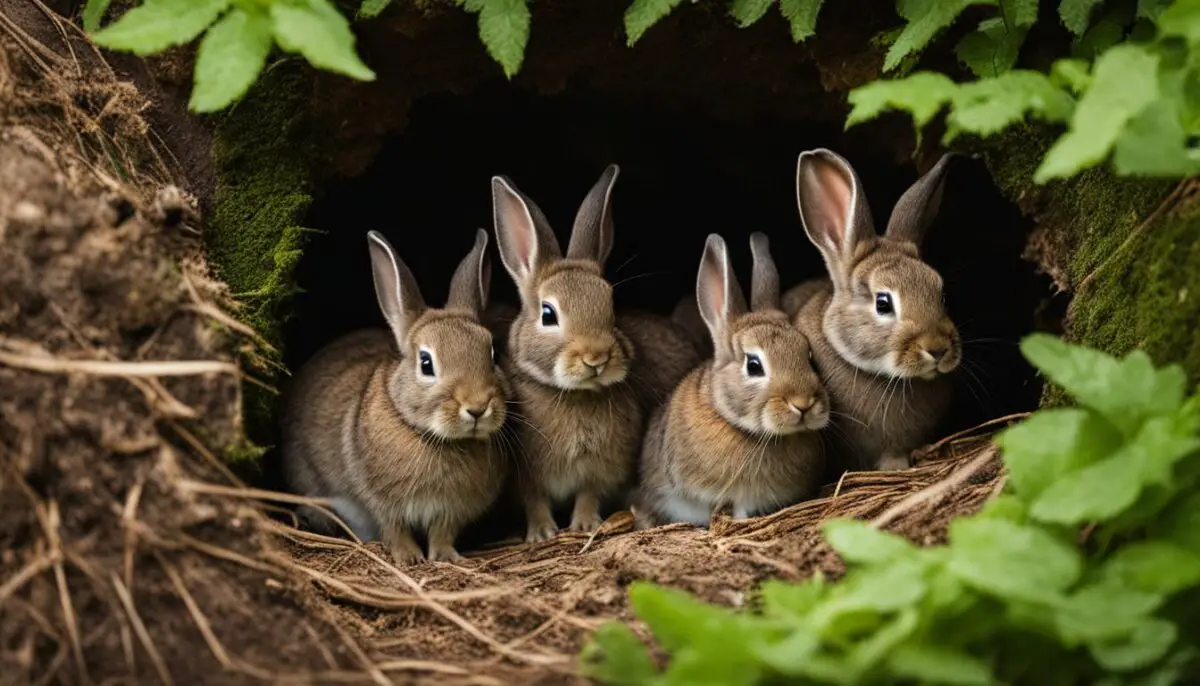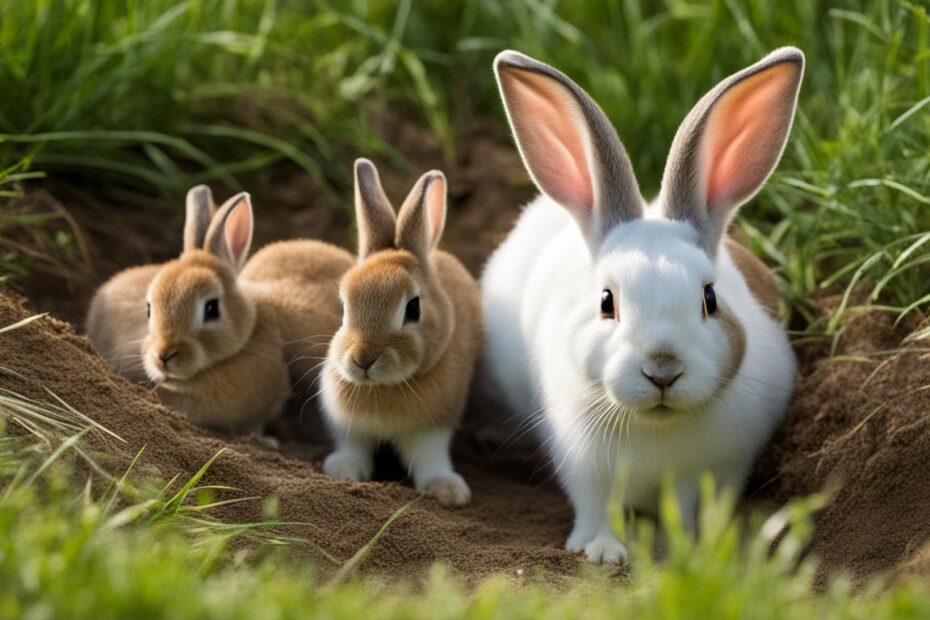Have you ever wondered if rabbits move their babies like some other animals do? It’s a common question among rabbit owners and enthusiasts. Let’s take a closer look at rabbit behavior with moving babies and explore the relocation habits of rabbits with babies.
Key Takeaways:
- Rabbits typically do not move their babies, unlike cats and some other animals.
- Rabbits’ mouths are not large enough to carry baby bunnies, and picking them up by the scruff can cause pain and discomfort.
- There are rare exceptions, such as wild European rabbits, that may occasionally move their young.
Will Rabbits Move Their Babies
Why Don’t Rabbits Use Their Mouths to Move Their Babies?
Rabbits do not use their mouths to move their babies primarily due to their small mouth size and the potential harm it can cause to the baby bunny’s skin. Unlike other animals, rabbits do not carry their kits by the scruff of the neck. Instead, mother rabbits may nudge their babies back to the nest if they wander away, but generally, they do not relocate them.
Rabbits have evolved to have smaller mouths compared to other animals, making it physically impossible for them to carry their babies in their mouths. Their mouths are designed for grazing on vegetation, not for transporting their young.will rabbits move their babies
Furthermore, picking up baby rabbits by the scruff of the neck can cause pain and discomfort for the little ones. The skin on their necks is delicate and can easily tear or become injured if handled in this way. Mother rabbits instinctively avoid causing harm to their offspring and have developed alternative methods for keeping their babies safe.do rabbits relocate their kits
“Rabbits do not use their mouths to move their babies primarily due to their small mouth size and the potential harm it can cause to the baby bunny’s skin.”
Why Don’t Rabbits Relocate Their Kits?
Rabbits also do not relocate their kits to new nests because they rely on the safety and familiarity of their current nest. Mother rabbits meticulously construct their nests in hidden locations, such as burrows or dense vegetation, to protect their babies from predators.why do rabbits move their baby rabbits
If a mother rabbit were to move her kits to a different location, it would increase their exposure to potential threats. By keeping the nest in one place, the mother can monitor the surroundings and ensure the safety of her babies.
In the wild, the nest is typically well-camouflaged, making it less likely to be discovered by predators. Moving the kits to a new nest would disrupt this natural camouflage and potentially expose them to danger.
The Importance of Motherly Instincts
While it may seem strange that rabbits do not use their mouths to move their babies, it is essential to understand that they have evolved unique instincts to care for their offspring. Instead of relying on carrying their kits like some other animals, rabbits have adapted behaviors that keep their babies safe in their natural environment.how often do rabbits move their babies
- Rabbits nudge their babies back to the nest if they wander away.
- They construct their nests in hidden locations to protect their kits from predators.
- Mother rabbits visit their babies once or twice a day to feed and clean them.
These instincts have developed over time through natural selection, allowing rabbits to successfully raise their young while minimizing the risk of harm.
Do All Rabbits Move Their Babies?
While most rabbits do not move their babies, there are exceptions. Wild European rabbits have been observed occasionally moving their young. The exact methods they use to accomplish this are not known. Overall, it is not a common behavior among domesticated rabbits.instincts of rabbits moving their kits
There are several reasons why rabbits may choose to move their babies. One reason could be to find a safer location for the nest, away from potential predators or disturbances. Another reason could be to provide a more suitable environment for their growing kits, such as finding a nest with better insulation or food availability. It is believed that these instincts are primarily driven by the mother rabbit’s natural drive to protect and ensure the survival of her offspring.reasons why rabbits move their babies
However, it is important to note that the majority of domesticated rabbits do not exhibit this behavior. Domestic rabbits, especially those kept as pets, are usually provided with a safe and secure environment, which eliminates the need for the mother to relocate her babies. In these cases, the mother rabbit relies on her instincts to keep the nest hidden and protect her offspring from potential threats.
Reasons Why Rabbits Move Their Babies:
- To find a safer location away from predators
- To provide a more suitable environment for their growing kits
- Mother rabbit’s natural drive to protect and ensure the survival of her offspring
Understanding the behavior of rabbits when it comes to moving their babies can help rabbit owners create a suitable and safe environment for their pets. By providing a secure nest, minimizing disturbances, and ensuring the mother rabbit has access to adequate resources, such as food and water, owners can help promote a healthy and stress-free environment for both the mother and her babies.how do rabbits move their babies
How Do Rabbits Protect Their Babies?
Rabbits have unique ways of protecting their babies to ensure their safety and survival. One of the main ways they do this is by keeping the nest site secret and hidden from potential predators. Mother rabbits carefully choose concealed locations, such as under bushes or in thick patches of grass, to build their nests. This helps to minimize the chances of the nest being discovered by predators like foxes, cats, or birds of prey.
Another way rabbits protect their babies is by visiting them only once a day, usually in the early morning. During this daily visit, the mother rabbit will feed and clean her babies. By limiting the amount of time spent at the nest, the mother reduces the risk of attracting predators due to scent or movement. This behavior also helps to keep the babies hidden and allows them to rest and stay warm in the nest throughout the day.
It’s important to note that mother rabbits are very sensitive to human interference and may abandon the nest if they feel it has been disturbed. Therefore, it is crucial to avoid touching or moving the babies unless absolutely necessary. Rabbits have their unique ways of protecting their young, and interfering with this natural process can harm the babies’ chances of survival.
What to Do If You Find a Baby Rabbit Nest
If you stumble upon a rabbit nest, it’s best to leave it undisturbed. Resist the temptation to check on the babies or move them. The mother rabbit is likely nearby, watching from a distance. Touching the babies or the nest can leave behind human scent, which may cause the mother to abandon her young. Instead, trust in the mother rabbit’s instincts and let her take care of her babies.
If you come across an injured baby rabbit, it is essential to seek professional help. Contact a veterinarian or a wildlife rehabilitator who can provide the necessary care and treatment for the injured rabbit. They have the expertise to handle the situation properly and ensure the well-being of the baby rabbit.

| Ways Rabbits Protect Their Babies | Benefits |
|---|---|
| Secreting the nest site | Minimizes the chance of predators finding the nest |
| Visiting the nest once a day | Reduces the risk of attracting predators |
| Avoiding human interference | Preserves the mother’s instinctual care for her babies |
When Do Kits Leave the Nest?
Kits, or baby rabbits, typically leave the nest when they are around 3 to 5 weeks old. At this stage, they are not completely independent but are starting to explore outside the nest. The mother rabbit may still visit them once or twice a day to feed them, but the kits are becoming more self-sufficient.
During this time, the kits begin to venture out of the nest to discover their surroundings. They may hop around nearby areas, nibble on vegetation, and practice their hopping and digging skills. However, they still return to the nest to sleep and seek comfort from their mother.
It is important to note that the exact age at which kits leave the nest can vary. Some may start exploring a little earlier or later depending on their individual development. It is also worth mentioning that while kits are leaving the nest, they still rely on their mother for nutrition and guidance as they learn to navigate their environment.
Summary:
- Kits leave the nest at around 3 to 5 weeks old.
- They are not completely independent and still rely on their mother for feeding and guidance.
- Kits begin exploring outside the nest but continue to return to sleep until they are around 4 to 5 weeks old.
Table: Age of Kits Leaving the Nest
| Age | Activity |
|---|---|
| 3-4 weeks | Kits start venturing outside the nest and exploring their surroundings |
| 4-5 weeks | Kits still return to the nest to sleep but are becoming more self-sufficient |
Do All Kits Leave the Nest Simultaneously?
While baby rabbits are born together and stay in the nest for a minimum of three weeks, they do not all leave the nest at the same time. Mother rabbits leave the kits alone after birth to protect them from predators. The kits venture outside on their own in the third or fourth week but still return to sleep in the nest. The mother rabbit continues to visit and feed them.
Factors Influencing Nest Departure
Several factors influence the timing of when baby rabbits leave the nest:
- Developmental milestones: Kits need to reach certain developmental milestones before they are ready to leave the nest. These milestones include the ability to regulate body temperature, hop independently, and consume solid foods.
- Maternal encouragement: Mother rabbits play a crucial role in encouraging their kits to leave the nest. They may nudge them out of the nest or lead them away gradually.
- Environmental cues: Kits may be more likely to leave the nest if they perceive a safe and suitable environment outside. This could be influenced by factors such as temperature, food availability, and the presence of sibling kits.
It’s important to note that while most kits leave the nest around the same time, there may be some variation in individual departure times. Some kits may be more adventurous and leave earlier, while others may take longer to gain the confidence to explore outside the nest.

Benefits of Gradual Departure
The gradual departure of kits from the nest offers several benefits:
- Increased survival chances: By leaving the nest at different times, kits reduce the risk of attracting predators to a concentrated area. This increases their chances of survival by spreading out the potential threats.
- Opportunity for individual growth: Each kit has the opportunity to develop independence and gain confidence at its own pace. Gradual departure allows them to explore the outside world while still having the security of the nest to return to if needed.
- Less stress on the mother: If all kits were to leave the nest simultaneously, the mother rabbit may struggle to provide adequate care and attention to each kit. Gradual departure allows her to focus on nurturing the remaining kits while others start their independent journeys.
In summary, while baby rabbits do not all leave the nest simultaneously, their departure occurs gradually over a period of time. Factors such as developmental milestones, maternal encouragement, and environmental cues influence when kits venture out. The gradual departure offers benefits in terms of survival chances, individual growth, and reduced stress on the mother rabbit.
What to Do If You Find an Injured Baby Rabbit in the Wild?
If you come across an injured baby rabbit in the wild, it is important to take the right steps to ensure its well-being. Here are some guidelines to follow:
- Assess the situation: Approach the injured rabbit cautiously and observe its behavior. If it appears to be in immediate danger or distress, you may need to intervene. However, keep in mind that wild animals can be unpredictable, so it’s best to keep your distance if possible.
- Contact a professional: Reach out to a local veterinarian or wildlife rehabilitator for guidance. They have the knowledge and experience to provide appropriate care and treatment for the injured rabbit. They will be able to assess the severity of the injury and determine the best course of action.
- Do not attempt to handle the rabbit yourself: Injured wildlife can be easily stressed, and handling them without the proper training can cause further harm. It’s important to let the professionals take care of the rabbit to ensure its safety and well-being.
- Provide temporary shelter: If the injured rabbit is in immediate danger and you cannot get immediate professional help, you can carefully place it in a well-ventilated box with soft bedding, such as a towel or blanket. Keep the box in a quiet and warm place away from noise and disturbance.
Remember, intervening with wild animals should always be a last resort. It’s essential to prioritize their safety and natural habitat. By seeking professional help, you can ensure the injured baby rabbit receives the appropriate care it needs without jeopardizing its chances of survival.
| Signs that an Injured Baby Rabbit Needs Help: | Signs that an Injured Baby Rabbit Does Not Need Help: |
|---|---|
|
|
Remember, it’s crucial to respect and protect wildlife. The best course of action when encountering an injured baby rabbit in the wild is to reach out to professionals who will provide appropriate care and treatment to ensure its well-being.

| Wild Bunnies’ Nesting Habits | Protection Methods | Feeding Schedule |
|---|---|---|
| Choose open areas like lawns or brush piles for nesting | Keeping the nest hidden to avoid attracting predators | About 5 minutes of nursing per day, in the morning and evening |
| Camouflage and protection from predators | Restoring and protecting disturbed nests | Mother visits the nest briefly to nurse the babies |
More Information
If you come across wild baby bunnies, it’s important to determine whether they truly need help before taking any action. It’s normal for mother rabbits to leave their babies alone for extended periods of time to minimize the risk of attracting predators. Removing the babies from the nest prematurely can actually decrease their chances of survival. So, before intervening, assess the situation carefully. If the babies appear healthy and the nest is undisturbed, it’s best to leave them be and allow the mother to continue caring for them.
However, if you encounter an injured baby bunny in the wild, it’s crucial to seek professional help. Contact a wildlife rehabilitator or a veterinarian with experience in treating wildlife. They will have the expertise and resources to provide proper care and treatment for the injured bunny. Trying to handle the bunny yourself may cause further harm and stress to the animal.
Remember, wild baby bunnies have the best chance of survival under the care of experienced professionals. So, if you find a wild baby bunny and are unsure whether it needs help, it’s always safer to seek guidance from a wildlife expert.
Conclusion
In conclusion, rabbits generally do not move their babies. Unlike cats, rabbits do not have the physical ability to carry their young in their mouths. Instead, mother rabbits protect their babies by keeping the nest site hidden and visiting them once a day in the morning. They provide care, feeding, and cleaning during these visits.
While most rabbits do not relocate their kits, there are exceptions in the wild. Wild European rabbits have been observed occasionally moving their young, although the exact methods they use are unknown. However, it is important to note that this behavior is not common among domesticated rabbits.
If you come across an injured baby rabbit in the wild, it is best to seek professional help. Contact a vet or wildlife rehabilitator who can provide the necessary care and medical attention. Attempting to handle the injured rabbit yourself may cause further harm. Remember, it is crucial to prioritize the well-being and survival of these delicate creatures.
FAQ
Will rabbits move their babies?
Rabbits typically do not move their babies. Unlike cats, rabbits do not carry their young in their mouths. Their mouths are not large enough to carry baby bunnies, and picking them up by the scruff of the neck can cause pain and discomfort. However, there are rare exceptions, such as wild European rabbits, that may occasionally move their young.
Why don’t rabbits use their mouths to move their babies?
Rabbits do not use their mouths to move their babies primarily due to their small mouth size and the potential harm it can cause to the baby bunny’s skin. Unlike other animals, rabbits do not carry their kits by the scruff of the neck. Instead, mother rabbits may nudge their babies back to the nest if they wander away, but generally, they do not relocate them.
Do all rabbits move their babies?
While most rabbits do not move their babies, there are exceptions. Wild European rabbits have been observed occasionally moving their young. The exact methods they use to accomplish this are not known. Overall, it is not a common behavior among domesticated rabbits.
How do rabbits protect their babies?
Rabbits protect their babies by keeping the nest site secret and visiting them only once a day in the early morning. Mother rabbits use this visit to feed and clean the babies. They keep the nest hidden to avoid attracting predators. For the rest of the day, the babies are left to sleep and stay warm in the nest.
When do kits leave the nest?
Kits, or baby rabbits, leave the nest when they are around 3 to 5 weeks old. They are not completely independent at this stage, as their mother still comes to feed them once or twice a day. They begin exploring outside the nest but continue to return to sleep in the nest until they are around 4 to 5 weeks old.
Do all kits leave the nest simultaneously?
While baby rabbits are born together and stay in the nest for a minimum of three weeks, they do not all leave the nest at the same time. Mother rabbits leave the kits alone after birth to protect them from predators. The kits venture outside on their own in the third or fourth week but still return to sleep in the nest. The mother rabbit continues to visit and feed them.
What to do if you find an injured baby rabbit in the wild?
If you come across an injured baby rabbit in the wild, it is best to contact a vet or wildlife rehabilitator for assistance. They can provide proper care and medical attention to ensure the rabbit’s well-being. Trying to handle the injured rabbit yourself may cause more harm than good.
What about wild bunnies?
Wild bunnies hide their nests in plain view, often in open areas like lawns or brush piles. If you find a disturbed bunny nest, it is best to restore and protect it rather than bringing the infants inside. Mother rabbits nurse their babies for about 5 minutes a day, typically in the morning and evening. It is important to avoid interfering with wild bunnies and let the mother care for her young.
What to do if you find wild baby bunnies?
If you find wild baby bunnies, it is important to determine if they truly need help before intervening. Wild baby bunnies are often left alone by their mothers and removing them from the nest can reduce their chances of survival. If you encounter an injured wild baby bunny, contact a wildlife rehabilitator for assistance.
Conclusion
In conclusion, rabbits generally do not move their babies, although there are exceptions in the wild. Mother rabbits protect their babies by keeping the nest site secret and visiting them once a day. Kits leave the nest at around 3 to 5 weeks old and continue to be cared for by their mother. If you come across an injured baby rabbit in the wild, seek professional help to ensure its proper care.


